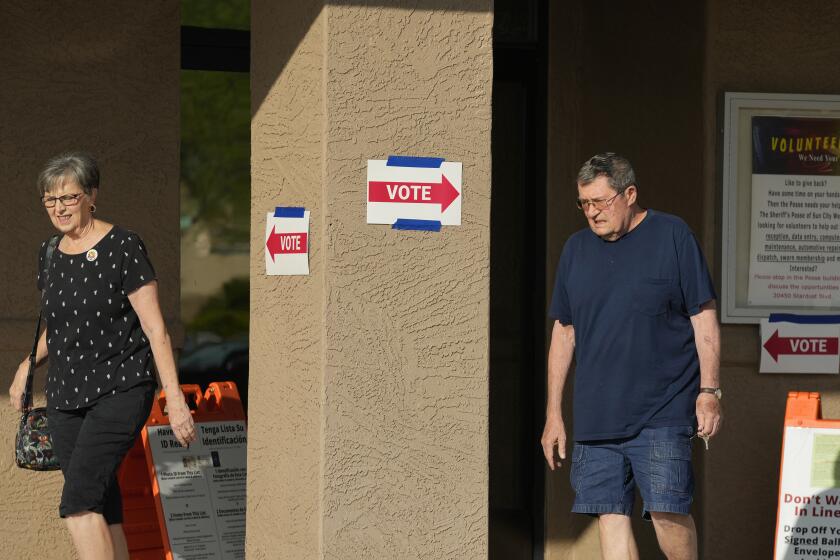Iraq Evidence ‘Manipulated,’ Inquiry Finds
A controversial intelligence unit set up in the Pentagon provided skewed prewar analysis to support Bush administration claims that Saddam Hussein was an ally of Al Qaeda, an investigation by Democrats on the Senate Armed Services Committee has found.
The intelligence unit, run by Undersecretary of Defense for Policy Douglas J. Feith, shaded analytic judgments, ignored contrary evidence and sidestepped the CIA to present dubious findings to senior officials at the White House, the investigation concluded.
The report was released Thursday by Sen. Carl Levin (D-Mich.) after a 16-month inquiry conducted by Democratic staff members on the committee. Levin has been a persistent critic of Feith and the Bush administration on Iraq.
The report concluded that “intelligence relating to the Iraq-Al Qaeda relationship was manipulated by high-ranking officials in the [Department of Defense] to support the administration’s decision to invade Iraq.”
Republicans criticized the report as politically motivated. “Sen. Levin’s report is clearly a partisan effort to influence the upcoming election rather than an attempt to correct the flaws in our intelligence community,” said Sen. John Cornyn of Texas, a Republican on the Senate Armed Services Committee.
The Defense Department issued a statement saying other investigations had found no evidence of wrongdoing by Feith’s office, and that Levin’s report appeared to “depart from the bipartisan, consultative relationship” between the Pentagon and Congress.
Feith, a lightning rod for critics of the Bush administration, was a leading proponent of the war in Iraq, and was in charge of postwar planning. He has said that his office created the intelligence unit -- the Counterterrorism Evaluation Group -- shortly after the Sept. 11 attacks to conduct a broad examination of state sponsors of terrorism.
The unit focused much of its energy on finding a link between Hussein and Al Qaeda. Subsequent investigations, including that of the independent bipartisan Sept. 11 commission, have concluded that although there were contacts between Iraq and Al Qaeda, there was no evidence of a collaborative relationship or Iraqi involvement in the Sept. 11 plot.
Much of the material in Levin’s report has been previously disclosed. But the 46-page document includes new details that, according to Levin, show how Feith’s analysts repeatedly sought to outflank the CIA, which was much more skeptical of Iraq-Al Qaeda ties.
The report found that the Defense analysts tailored presentations to different audiences, making a more aggressive case when briefing senior officials at the Pentagon and the White House than when showing their findings to senior CIA officers.
At the White House, for instance, Pentagon briefers included a slide describing “known Al Qaeda contacts,” and listing an alleged meeting in Prague between Sept. 11 hijacker Mohamed Atta and an Iraqi intelligence agent.
Levin said that far from being a known example of contacts between Iraq and Al Qaeda, there was widespread doubt in the intelligence community that the meeting ever occurred. Nevertheless, he said, the claim was included in the Sept. 16, 2002, White House briefing even though it was not part of a previous presentation made to then-CIA Director George J. Tenet and other senior officials at agency headquarters.
The report also cites instances in which Pentagon analysts failed to fully comply with CIA requests that exaggerated claims be deleted or corrected. In one case, the CIA warned Feith’s office against using a claim that Hussein’s regime knew that suspected terrorist Abu Musab Zarqawi had entered Iraq, saying the assertion was “unsupported” by the intelligence cited.
Rather than remove the long-disputed claim, the Pentagon intelligence unit left it unchanged and “cited a different CIA report in support of [the] assertion,” Levin’s report said.
Levin said distortions by analysts working for Feith fueled many of the Bush administration’s most controversial claims as it made its case for war. In particular, he noted that Vice President Dick Cheney referred to a magazine article cataloging many of the Feith team’s controversial findings as the “best source of information” on the relationship between Iraq and Al Qaeda.
“It wasn’t the best source,” Levin said. “It was an inaccurate, exaggerated source which the CIA insisted be corrected.”
More to Read
Get the L.A. Times Politics newsletter
Deeply reported insights into legislation, politics and policy from Sacramento, Washington and beyond. In your inbox three times per week.
You may occasionally receive promotional content from the Los Angeles Times.










